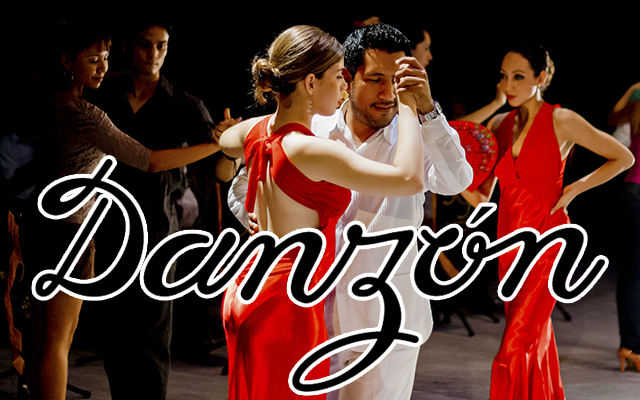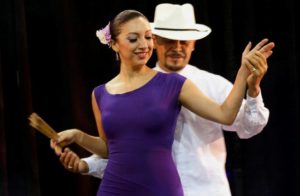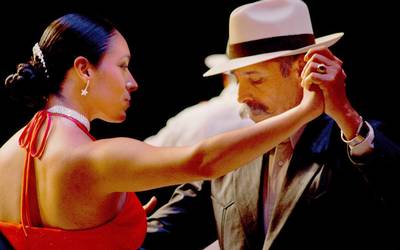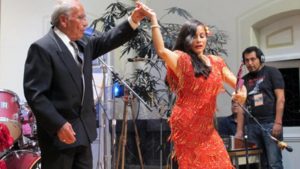 EL DANZÓN, EL GÉNERO MUSICAL QUE UNE MÁS A MÉXICO CON CUBA. VIDEOS.
EL DANZÓN, EL GÉNERO MUSICAL QUE UNE MÁS A MÉXICO CON CUBA. VIDEOS.
El popular género musical ‘Danzón’ nació en Matanzas, Cuba a principios de 1879. Derivado de una contradanza francesa titulada ‘Las alturas de Simpson’, tuvo éxito de inmediato y se convirtió en el género musical más importante en la isla. Sin embargo, decayó a principios del siglo XX frente a otros géneros como el son y el casino. En México es uno de los géneros más bailados, con clubes establecidos en todo el país.
El danzón llegó a México por el camino de la mar, como un grumete sonoro entró por Yucatán y Veracruz a finales del siglo XIX y su andar por estas tierras es una muestra de su increíble capacidad para ajustarse a otros públicos, otros ambientes, formatos y necesidades. El danzón en México no es simple calco del nuestro, su evolución ha respondido a la demanda de los danzoneros mexicanos y ya es tan suyo como nuestro.
Según Ethiel Failde, director de orquesta danzonera y tataranieto del creador del Danzón Miguel Failde sobre la diferencia entre la popularidad el danzón entre México y Cuba nos dice ..“Yo soy de la opinión de que en Cuba han evolucionado mucho más los aspectos musicales y en México los relativos al baile, al acto social que implica el disfrute del danzón. Ello, gracias a la infinidad de clubes devenidos en academias, eventos, salones y promotores incansables distribuidos por prácticamente todo el país.
“Por mencionar algunas diferencias estrictamente musicales, te comento que la célula rítmica del danzón integrada por el cinquillo cubano y las cuatro corcheas que le siguen son ligeramente floreadas en la isla caribeña, algo que en México está enraizado todavía en el danzón de principios del siglo XX sin salirse de ese patrón rítmico; acá suelen utilizar en los tríos de clarinete y violín, es decir, en la parte B y C de la forma rondó, la clave del son cubano.Existen diferencias en cuanto al formato orquestal que en México es más cercano al formato inicial, como la nómina que encabezaba Miguel Faílde y más aún a las jazz band por esa abundante fila de metales y saxofones; es raro encontrar violines como en Cuba. El formato más representativo para este género es la Orquesta Charanga, en el que violines y flauta juegan un rol primordial.
“Debo mencionar el uso del timbal o pailas, instrumento que en mi país sólo se encuentra dentro del formato de las orquestas típicas o de viento, agrupaciones casi patrimoniales que responden al formato del siglo XIX, pues lo usual es que el danzón y los demás géneros de la música cubana se interpretan con las pailitas cubanas o timbal/latin drums como son conocidas en el mundo.
“Otra característica que nos diferencia son las improvisaciones o palomazos, como se conoce en tierras aztecas, algo que no es bien visto por los bailadores mexicanos que ejecutan una coreografía y que, sin embargo, en la isla es un recurso muy explotado, sobre todo en la flauta, el piano, incluso las pailitas; allá se baila al estilo libre y los bailadores están más acostumbrados a ese momento consagrado al lucimiento del instrumentista.”
A la pregunta de si en México es más popular el danzón que en Cuba nos dice.. “Si nos atenemos a las estadísticas, diría que sí, en México la población es exponencialmente más grande que en Cuba y la comunidad danzonera es mayor. No veo aquí una gran presencia del danzón en los medios, pero sí la labor espontánea de clubes, academias y eventos”.
“Es usual encontrar en las guías turísticas los bailes de danzón de Veracruz o Ciudad de México como algo a considerar por los visitantes, por ser un fenómeno profundamente arraigado en la práctica cultural y el imaginario social. Reitero: en el aspecto musical su evolución no ha sido tan prolífica como en Cuba en cuanto a novedades, añadiduras y aspectos puramente musicales.”
El danzón como género musical pertenece tanto a México como a Cuba desde donde salió hacia el mundo.
 EL DANZÓN, THE MUSICAL GENDER THAT UNITES MORE MÉXICO TO CUBA. VIDEOS.
EL DANZÓN, THE MUSICAL GENDER THAT UNITES MORE MÉXICO TO CUBA. VIDEOS.
The popular musical genre ‘Danzón’ was born in Matanzas, Cuba in early 1879. Derived from a French contradanza entitled ‘The Heights of Simpson’, it was immediately successful and became the most important musical genre on the island. However, it declined at the beginning of the 20th century against other genres such as son and casino. In México, it is one of the most danced genres, with established clubs throughout the country.
The danzon arrived in México by the way of the sea, as a sound rumble entered through Yucatan and Veracruz at the end of the 19th century and its walk through these lands is a sample of its incredible ability to adjust to other audiences, other environments, formats and needs The danzon in Mexico is not a simple copy of ours, its evolution has responded to the demand of the Mexican dancers and is already as theirs as ours.
According to Ethiel Failde, director of the Danzone and great-great-grandson orchestra of the creator of Danzón Miguel Failde, about the difference between popularity, the danzon between Mexico and Cuba tells us… “I am of the opinion that in Cuba the musical aspects have evolved much more and in Mexico, those related to dance, to the social activities that imply the enjoyment of danzón. This, thanks to the infinity of clubs become academics, events, halls and tireless promoters distributed practically throughout the country.
“To mention some strictly musical differences, I tell you that the rhythmic cell of the danzón integrated by the Cuban cinquillo and the four eighths that follow it are slightly flowered on the Caribbean island, something that in Mexico is still rooted in the danzon of the beginning of the century XX without leaving that rhythmic pattern; here they usually use the clarinet and violin trios, that is, in part B and C of the rondo form, the key to the Cuban son. There are differences in the orchestral format that in Mexico is closer to the initial format, such as payroll led by Miguel Faílde and even more to the jazz band for that abundant row of metals and saxophones; It is rare to find violins as in Cuba. The most representative format for this genre is the Charanga Orchestra, in which violins and flute play a primary role.
“I must mention the use of the timbale or pailas, an instrument that in my country is only within the format of the typical or wind orchestras, almost patrimonial groups that respond to the format of the 19th century, since the usual thing is that the danzón and the others Cuban music genres are interpreted with the Cuban pailitas or timbal / Latin drums as they are known in the world.
“Another characteristic that differentiates us is improvisations or dovecotes, as is known in Aztec lands, something that is not well seen by Mexican dancers who perform a choreography and that, however, on the island is a very exploited resource, especially on the flute, the piano, even the pailitas; there they dance in their freestyle and the dancers are more accustomed to that moment devoted to the performance of the instrumentalist. ”
To the question of whether in Mexico the danzon is more popular than in Cuba it tells us .. “If we stick to the statistics, I would say yes, in Mexico the population is exponentially larger than in Cuba and the Danzone community is larger. No, I see here a great presence of danzón in the media, but the spontaneous work of clubs, academies, and events. ”
“It is usual to find in the tourist guides the dances of danzón from Veracruz or Mexico City as something to be considered by visitors, as it is a phenomenon deeply rooted in cultural practice and the social imaginary. I reiterate: in the musical aspect its evolution has not been as prolific as in Cuba in terms of novelties, additions and purely musical aspects. ”
Danzon as a musical genre belongs to both Mexico and Cuba from where it left for the world.
Agencies/ Excelsior/ Rosario Manzanos/ Extractos/ Excerpts/ Internet Photos/ YouTube/ Arnoldo Varona/ www.TheCubanHistory.com
THE CUBAN HISTORY, HOLLYWOOD.










